Minotaur V rocket and LADEE spacecraft launch trajectory view as should be seen from atop the Empire State Building, NY, on Sept. 6, 2013 at 11:27 p.m. EDT – weather permitting.
See more launch trajectory viewing graphics below[/caption]
WALLOPS ISLAND, VA – An unprecedented spectacle is set to light up the skies this Friday night, Sept. 6, courtesy of NASA when America returns to the Moon with the history making nighttime launch of the LADEE lunar orbiter atop a retired and specially converted intercontinental ballistic missile (ICBM) from NASA’s Wallops Island facility on the Virginia shoreline.
Blastoff of NASA’s Lunar Atmosphere and Dust Environment Explorer (LADEE) Observatory atop the maiden flight of the powerful new Minotaur V rocket is slated for 11:27 p.m. EDT Sept. 6 from Launch Pad 0B along the Eastern Shore of Virginia at NASA Wallops.
Because it’s at night and lifting off from the most densely populated region of the United States, the flames spewing from the tail of Minotaur could be visible to tens of millions of distant spectators – weather permitting – who have never before witnessed such a rocket launch.
So you don’t have to be watching locally to join in the fun and excitement. And you can always watch the NASA TV webcast online on a smartphone or laptop.
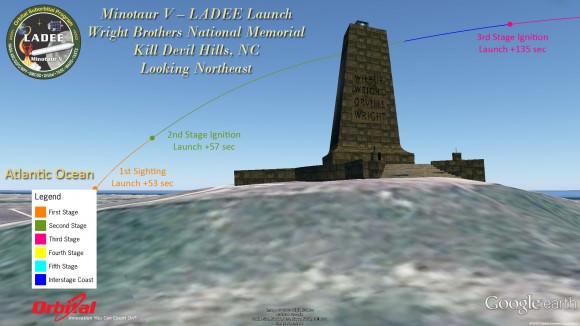
The LADEE (pronounced ‘laddie’ not ‘lady’) launch is historic in many ways.
No space satellite has ever been launched to beyond Earth orbit from NASA’s Wallops’s launch base in Virginia, it’s the first flight to the Moon from Wallops, the first Minotaur V rocket launch based on the Peacekeeper missile, and it’s the first flight of the revolutionary new modular spacecraft design aimed at significantly cutting the cost of exploring space.
So although the very best views are available from local areas in Virginia, Maryland and Delaware just tens of miles away from the Wallops Island launch pad, magnificent viewing opportunities are available from a broad region up and down the East Coast and into the interior.
Let’s look at some viewing maps courtesy of Orbital Sciences, the company responsible for assembling the Minotaur V and integrating it with the LADEE spacecraft – built by NASA’s Ames Research Center.
First up is the Maximum elevation map showing how high the rocket will be visible in degrees from the heavily populated US East Coast stretching from Maine to both Carolinas and into the industrial Midwest.
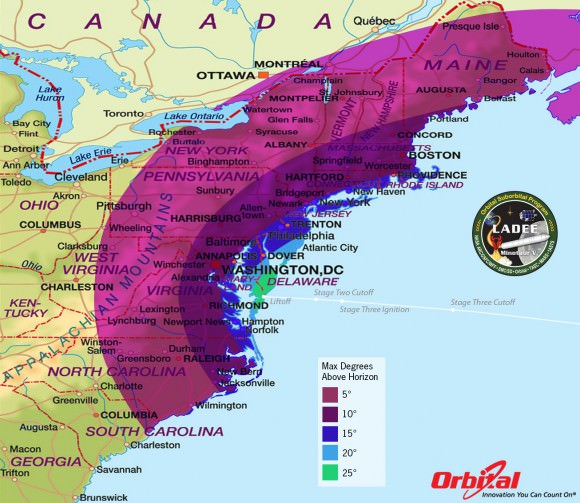
The LADEE nighttime launch will be visible to millions of spectators across a wide area of the Eastern US -weather permitting. This map shows the maximum elevation (degrees above the horizon) that the Minotaur V rocket will reach during the Sep. 6, 2013 launch depending on your location along the US east coast. Credit: Orbital Sciences
Herein are a series of graphics showing the Minotaur V trajectory and what you should see – during firings of the first three stages – from the perspective of standing on the ground or skyscrapers at a variety of popular destinations including the US Capitol, Lincoln Memorial, Kitty Hawk, NC, Atlantic City, NJ, New York City, Cape Cod and more.
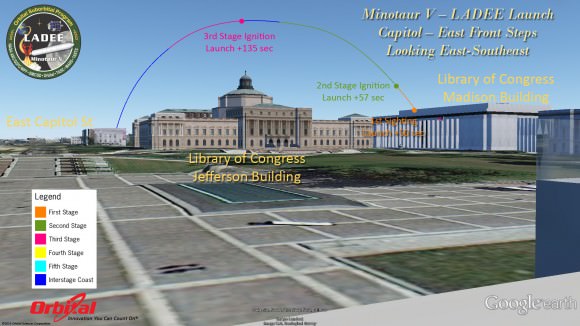
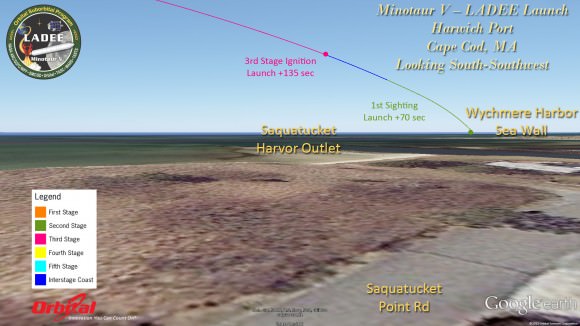
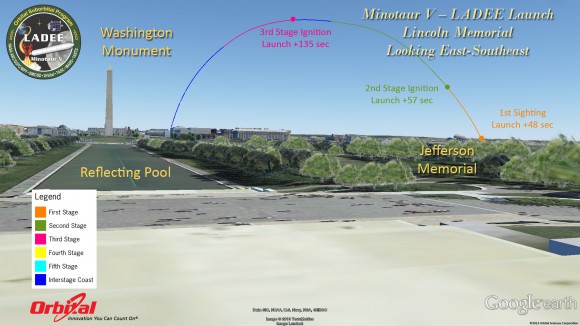
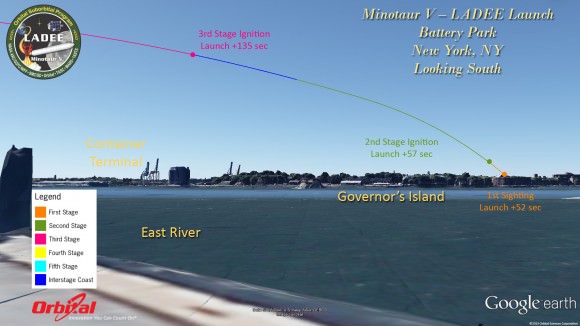
The five stage Minotaur V rocket stands 80.6 feet (24.6 meters) tall, is 7.6 feet (2.3 m) in diameter and weighs 197,034 pounds (89,373 kilograms.
The first three stages of the Minotaur V are based on the nuclear armed Peacekeeper ICBM intercontinental ballistic missile built during the Cold War – now retired and refurbished by Orbital for peaceful uses. It’s literally beating swords into plowshares.
The 5th stage is a new addition and what makes this Minotaur a new rocket class. The added thrust is precisely what enables shooting for the Moon.
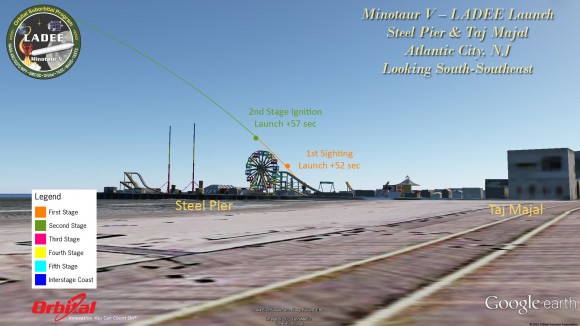
For anyone coming to the Wallops area for an eyewitness view of the launch, NASA worked with local officials to establish several viewing locations just 10 miles or so from the launch pad at the Mid-Atlantic Regional Spaceport, at NASA’s Wallops Flight Facility, Wallops Island, Va.
Visitors to the area may view the launch from Robert Reed Park on Chincoteague or Beach Road spanning the area between Chincoteague and Assateague Islands.
Both sites will feature a live countdown and broadcast and NASA personnel will be on hand to discuss the LADEE launch and goals of the mission.
A big-screen projector will broadcast live in Robert Reed Park beginning at 9:30 p.m.
“We’re excited about this partnership with the community in providing an enhanced launch experience to members of the public,” said Jeremy Eggers, public information officer for NASA Wallops in a statement. “The live countdown and launch broadcast will place people in mission control on launch night for what is already a historic mission for Wallops and the Eastern Shore.”
NASA TV starts a live broadcast of the launch at 9:30 p.m. on Sept 6 – available here: http://www.nasa.gov/ntv
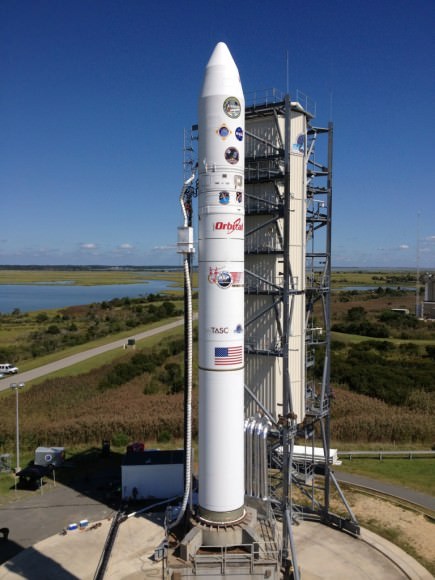
The couch sized 844 pound (383 kg) robotic explorer is equipped with 3 science instruments and a laser technology demonstrator.
These include an ultraviolet and visible light spectrometer that will gather detailed information about the composition of the tenuous lunar atmosphere; a neutral mass spectrometer to measure variations in the lunar atmosphere over time; a laser dust experiment that will collect and analyze dust particle samples; and a laser communications experiment that will test the use of lasers in place of radio waves for high speed data communications with Earth.
Be sure to watch for my continuing LADEE and Antares launch reports from on site at NASA’s Wallops Launch Pads in sunny Virginia – reporting for Universe Today.
…………….
Learn more about LADEE, Cygnus, Antares, MAVEN, Orion, Mars rovers and more at Ken’s upcoming presentations
Sep 5/6/16/17: “LADEE Lunar & Antares/Cygnus ISS Rocket Launches from Virginia”; Rodeway Inn, Chincoteague, VA
Oct 3: “Curiosity, MAVEN and the Search for Life on Mars – (3-D)”, STAR Astronomy Club, Brookdale Community College & Monmouth Museum, Lincroft, NJ, 8 PM
Oct 8: “LADEE Lunar & Antares/Cygnus ISS Rocket Launches from Virginia”; Princeton University, Amateur Astronomers Assoc of Princeton (AAAP), Princeton, NJ, 8 PM
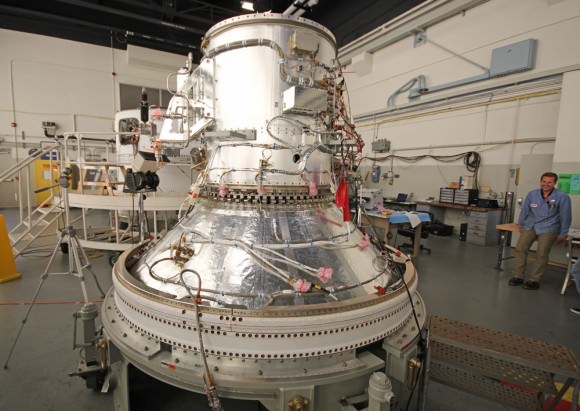
Close-up view of STAR 37 5th stage solid fuel motor for inaugural Minotaur V rocket launch at NASA Wallops rocket facility will propel LADEE into its lunar transfer orbit. LADEE will be mounted on top and surrounded by the payload fairing attached at bottom ring. Credit: Ken Kremer/kenkremer.com

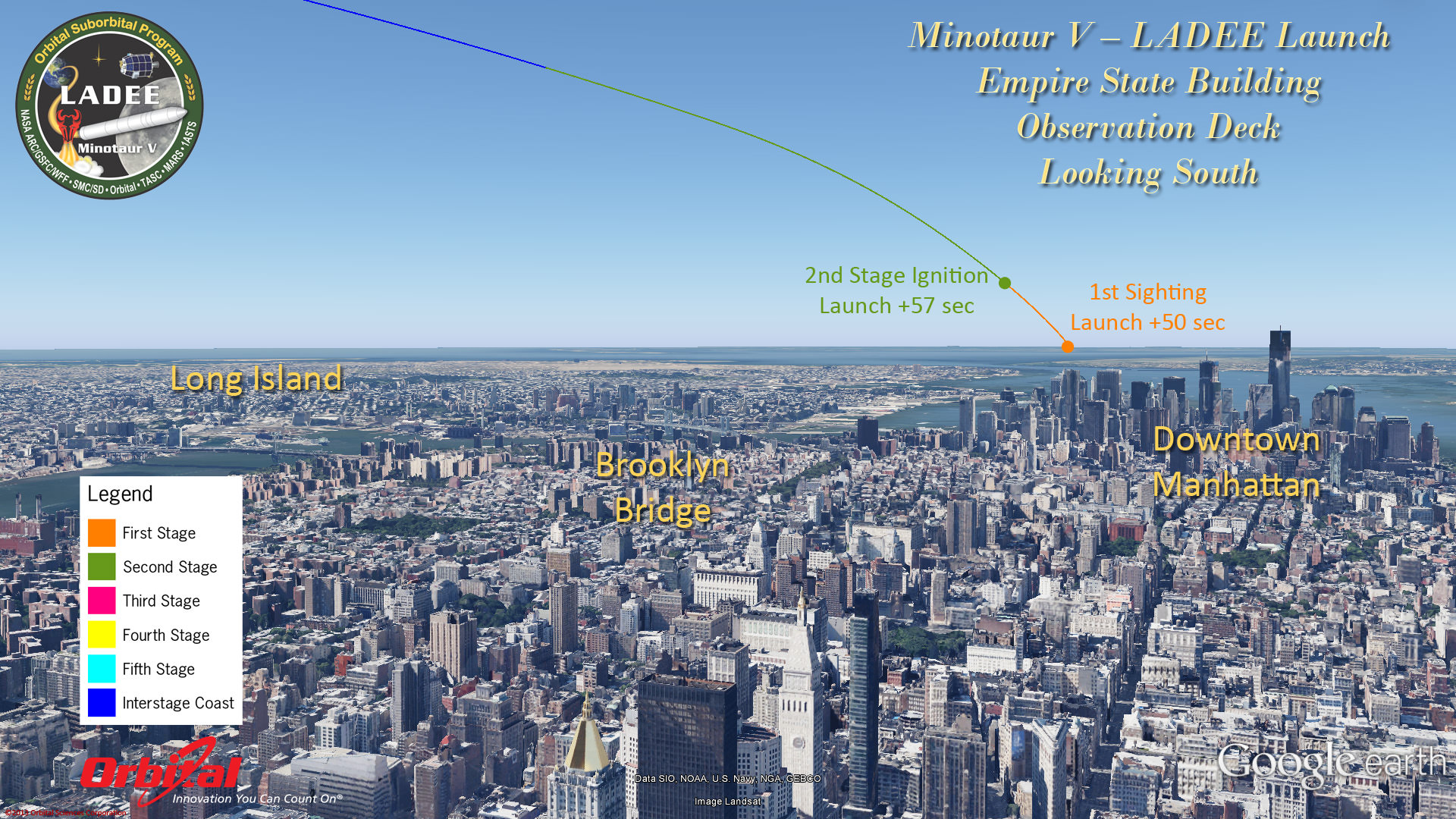
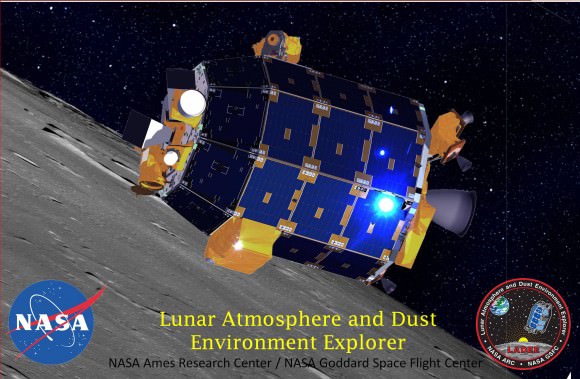
What’s with all the random links in the first part of the article?
They are linking you to more information about the mission
What should we expect this to look like from New York City? A shooting star with a long tail? Just trying to get a sense of the scale so we know what to look for.
I imagine it will look like a bright star, moving faster than a distant airplane, but slower than a shooting star. It may twinkle a bit.
Unfortunately I am traveling this weekend. I live in a great place to see it, but I will be just beyond the 5 degree line. 🙁
Thanks!
you should also be able to see the stages burn out and the next one re-light….it will be worth the watch!
Is that so? Than why are most of them removed now?
You must have seen something that I did not. The links when I look at this page are the same as the first time that I looked at this page.
Can’t we just download the software used to make those images and plug in our home address?
Exciting can’t wait to see it here in Southern New Jersey
“It’s literally beating swords into plowshares.” I’d say figuratively.
Thanks for this. The view was awesome. Knew just where to look 😉
way off, from northern new York it was like 20 degrees not 5 degrees
Someone said that there will be another launch at this location in 2 weeks taking supplies to the space station. I missed seeing this last night from my south jersey home and would like to see the next launching. Will there be another launch?
“It’s literally beating into plowshares.” I must have literally missed this. I saw nothing of the sort.